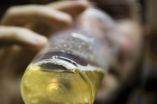Microglia have been implicated in many neurodegenerative and inflammatory brain disorders, underscoring the need to study and understand these cells. Dr Ginhoux's team is the first to show that microglia, unlike other white blood cells, are derived from a particular structure in the mouse embryo (the embryonic yolk-sac), implying that microglia may have specific functional properties not shared by other white blood cells.
In addition, Dr Ginhoux is the first to directly visualise how microglia develop in the brain. This will advance basic understanding of the mouse immune system, which is needed to understand how controlling the development of the precursors of microglia may one day be used to treat brain diseases in humans.
Prof Paola Castagnoli, Scientific Director of SIgN, commented, "Neurodegenerative diseases and inflammatory brain disorders are a major cause of suffering in the world. At SIgN, our focus and mission is to study human immunology and in particular, inflammatory reactions in human diseases. Inflammation occurs when the immune system overreacts to "danger" signals that can either be infectious or non-infectious, for instance, caused by cell or tissue damage. We know that the immune system does not work in isolation within the body, and that the interactions between immune and brain cells is occurring all the time. Therefore a better knowledge of the microglial cells' function and origin will open new avenues in the field of neuro-immunology."
Said Dr Ginhoux, "Several key experiments which were crucial to my work could only have been completed in SIgN. In particular, my work involved the use of a type of microscopy to directly visualise, in a living cell culture, how microglia colonise the brain. This is the first time this sort of work has been done, and it couldn't have been possible without the help of Dr. Lai Guan Ng, my colleague here at SIgN."
Dr Ginhoux plans to continue his investigation into how the unique origin of microglia, as compared to other white blood cell populations in the body, could give rise to the properties of microglia that makes them especially suitable for their role in the brain.
INFORMATION:
Notes to the Editor:
Research publication:
The research findings described in the press release can be found in the 21 October, 2010 advance online issue of Science under the title "Fate Mapping Analysis Reveals That Adult Microglia Derive from Primitive Macrophages".
Authors:
Florent Ginhoux,1,2,3,* Melanie Greter,1,2 Marylene Leboeuf,1,2 Sayan Nandi,4 Peter See,3 Solen Gokhan,5,6,7 Mark F. Mehler,5,6,7,8,9 Simon J. Conway,10 Lai Guan Ng,3 E. Richard Stanley,4 Igor M. Samokhvalov,11 Miriam Merad1,2,*
1 Department of Gene and Cell Medicine, Mount Sinai School of Medicine, 1425 Madison Avenue, New York, NY 10029, USA.
2 The Immunology Institute, Mount Sinai School of Medicine, 1425 Madison Avenue, New York, NY 10029, USA.
3 Singapore Immunology Network (SIgN), 8A Biomedical Grove, IMMUNOS Building #3-4, BIOPOLIS, 138648, Singapore.
4 Department of Developmental and Molecular Biology, Albert Einstein College of Medicine, 1300 Morris Park Avenue, Bronx, NY 10461, USA.
5 Institute for Brain Disorders and Neural Regeneration, Albert Einstein College of Medicine, 1410 Pelham Parkway South, Bronx, NY 10461, USA.
6 The Rose F. Kennedy Center for Research on Intellectual and Developmental Disabilities, Albert Einstein College of Medicine, 1410 Pelham Parkway South, Bronx, NY 10461, USA.
7 Department of Neurology, Albert Einstein College of Medicine, 1410 Pelham Parkway South, Bronx, NY 10461, USA.
8 Department of Neuroscience, Albert Einstein College of Medicine, 1410 Pelham Parkway South, Bronx, NY 10461, USA.
9 Department of Psychiatry and Behavioral Sciences, Albert Einstein College of Medicine, 1410 Pelham Parkway South, Bronx, NY 10461, USA.
10 Herman B Wells Center for Pediatric Research, Indiana University School of Medicine, 1044 West Walnut Street, Indianapolis, IN 46202, USA.
11 Laboratory for Stem Cell Biology, Center for Developmental Biology, RIKEN Kobe, Kobe 6500047, Japan.
* To whom correspondence should be addressed. E-mail: Miriam.Merad@mssm.edu (M.M.); Florent_ginhoux@immunol.a-star.edu.sg (F.G.)
Agency for Science, Technology and Research (A*STAR)
For more information, please contact:
Joshua Tan (Mr)
Corporate Communications
Agency for Science, Technology and Research (A*STAR)
Tel: (65) 6826 6353
Email: joshua_tan@a-star.edu.sg
About the Singapore Immunology Network (SIgN)
The Singapore Immunology Network (SIgN), officially inaugurated on 15 January
2008, is a research consortium under the Agency for Science, Technology and
Research (A*STAR)'s Biomedical Research Council. The mandate of SIgN is to
advance human immunology research and participate in international efforts to
combat major health problems. Since its launch, SIgN has grown rapidly and
currently includes 150 scientists from 25 different countries of the world working
under 20 renowned principal investigators. At SIgN, researchers investigate
immunity during infections and inflammatory conditions including cancer and are
supported by cutting edge technological research platforms and core services.
Through this, SIgN aims to build a strong platform in basic human immunology
research for better translation of research findings into clinical applications. SIgN
also sets out to establish productive links with local and international institutions, and
encourage the exchange of ideas and expertise between academic, industrial and
clinical partners and thus contribute to a vibrant research environment in Singapore.
For more information about SIgN, please visit www.sign.a-star.edu.sg.
About the Agency for Science, Technology and Research (A*STAR)
The Agency for Science, Technology and Research (A*STAR) is the lead agency for
fostering world-class scientific research and talent for a vibrant knowledge-based
and innovation-driven Singapore. A*STAR oversees 14 biomedical sciences, and
physical sciences and engineering research institutes, and seven consortia &
centres, which are located in Biopolis and Fusionopolis, as well as their immediate
vicinity.
A*STAR supports Singapore's key economic clusters by providing intellectual,
human and industrial capital to its partners in industry. It also supports extramural
research in the universities, hospitals, research centres, and with other local and
international partners.
For more information about A*STAR, please visit www.a-star.edu.sg.
END
